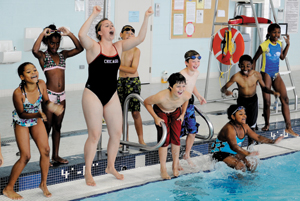Toes in the water
By Noah Berlatsky, AM’94
Photography by Dan Dry
On a Saturday morning in spring, children populate nearly every area in the Ratner Athletics Center pool—mostly three- to five-year-olds, but some as old as 12. Many are playful, jumping about in the water, while others clamber on instructors, insisting they are not going to put their faces in the water. A dozen or so camera-wielding parents watch from the balcony—or, occasionally, poolside if a particularly nervous child insists.

Third-year swim-team member Cassie O’Neill cheers on children at the Super Summer Sports Camp. During the school year she teaches smaller groups of swimmers.
It’s an uncommon scene at the Myers-McLoraine swimming pool, where the water is typically dominated by industrious lap swimmers. Still, the children arrive Wednesdays and Saturdays during the fall and spring for the University of Chicago Community Swim School (UCCSS). A $60 fee for four to six classes, depending on the day of the week, makes the school affordable for a wide range of students, and program director Ellen Bator estimates that only one-third have a University affiliation.
Varsity swimmers make up the instructor staff, and the program is meant not only to teach children basic water strokes, notes Bator, Chicago’s assistant swim coach, but also to give team members an opportunity to perform community service. So if you’re on the team, “you’d better have a really good reason” if you can’t teach a session. The lone exception is for incoming freshmen, who get their first quarter off.
Not that many team members see teaching duties as a hardship. Funds from the school help defray the cost of the team’s annual winter vacation—usually to Florida or, every four years, abroad (this winter break they head for Costa Rica). Moreover, the swimmers often help each other with strokes and skills, so teaching comes naturally.
Teacher training consists of a one-day course led by the team’s coaches in which the undergraduates learn games that teach water skills, like “red light, green light,” and how to deal with reluctant swimmers. They also brush up on noncompetitive strokes such as elementary backstroke and sidestroke. Then they’re ready to get in the water with their pupils.
It’s “amazing” to watch the swimmers progress, says Catie Cottle, a second-year long-distance swimmer and economics major. As a few team members do each year, she’s started giving private lessons to some UCCSS families. One such four-year-old student, she says, slipped off a kickboard, got a mouthful of water, and made her promise never to make him use a board again. She finally convinced him to get back on, assuring him that she would never, ever let go. Of course, she eventually did let go, surreptitiously. He “was actually really excited when he found out he was kicking by himself,” she recalls, “so now he begs to use kickboards.”
Pupils receive lots of individual attention; the school prides itself on its low student-teacher ratio—two or three swimmers per instructor in the younger classes and three or four per instructor for older ones. With little active marketing since UCCSS began in 2004, interest has nevertheless increased: last spring all 100 slots were filled only two weeks after enrollment opened. Parent Tianna Cervantez hopes the program will expand, noting that her nine-year-old son “wishes the classes were longer” and that there were more of them.
But the school’s growth has limits. Because Ratner is primarily intended to serve the Chicago student body, the schedule allows only 35- or 45-minute class sessions, depending on the session and day of the week. The team’s size and the swimmers’ availability are also factors. Head coach Jason Weber has successfully recruited a large group—in 2008–09 he expects to see about 60 men and women, up from 47 last season. But no matter how big the team gets, most of the members aren’t around outside the school year, so UCCSS doesn’t operate in the summer (although some swimmers teach at Myers-McLoraine during the athletics-department–sponsored Super Summer Sports Camp).
Despite these obstacles, UCCSS has expanded its services. This fall, for the first time, it offers classes to adult nonswimmers. And an anonymous donor will fund one or two scholarships each session to students with financial needs. The UCCSS staff hope the changes bring even more shrieking children—as long as they do so in the water.
Return to top